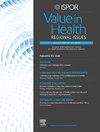Evaluating the Cost-Effectiveness of Pharmacological Therapy in Alzheimer Disease in Brazil
IF 1.4
Q3 HEALTH CARE SCIENCES & SERVICES
引用次数: 0
Abstract
Objectives
Alzheimer disease (AD) is a worsening neurodegenerative disorder and the leading cause of dementia, accounting for 60% to 70% of cases. It contributes significantly to disability, caregiver reliance, and is the eighth leading cause of death. AD is one of the most expensive diseases to treat, creating an economic burden for the healthcare system and families of patients. Dementia care costs in Brazil are projected to reach $49.2 billion by 2030, $63.5 billion by 2040, and $77.3 billion by 2050. This study evaluated the cost-effectiveness of acetylcholinesterase inhibitors (standard of care [SoC]) in slowing disease progression compared with no pharmacological therapy (best supportive care [BSC]), lecanemab, and donanemab in mild AD patients.
Methods
We developed a decision-analytic model to simulate AD progression, using cost and health utility data specific to Brazil, supplemented with data from the literature when necessary. The model covers a 20-year horizon from both the Brazilian national healthcare system and societal perspectives. Costs and quality-adjusted life years (QALYs) were discounted at 3.5% per year to reflect their present value. Costs in local currencies were converted to US dollars (US$) and inflation-adjusted to 2024 values.
Results
In the base-case analysis from the healthcare perspective, SoC was more clinically effective than BSC with a cost per QALY of $5211. For lecanemab versus SoC, the cost per QALY gained was $2 098 225, whereas donanemab versus lecanemab was $1 460 400.
Conclusions
The SoC is a cost-effective pharmacological intervention for AD, offering the lowest cost per QALY gains over a 20-year period.
评估巴西阿尔茨海默病药物治疗的成本-效果
目的阿尔茨海默病(AD)是一种日益恶化的神经退行性疾病,是痴呆症的主要原因,占病例的60%至70%。它严重导致残疾和对照顾者的依赖,是第八大死亡原因。阿尔茨海默病是治疗费用最高的疾病之一,给医疗保健系统和患者家庭带来了经济负担。巴西的痴呆症护理费用预计到2030年将达到492亿美元,到2040年将达到635亿美元,到2050年将达到773亿美元。本研究评估了乙酰胆碱酯酶抑制剂(标准治疗[SoC])与无药物治疗(最佳支持治疗[BSC])、莱卡耐单抗和多纳耐单抗在轻度AD患者中减缓疾病进展的成本-效果。方法我们开发了一个决策分析模型来模拟AD的进展,使用巴西特有的成本和健康效用数据,必要时补充文献数据。该模型涵盖了巴西国家医疗保健系统和社会视角的20年视野。成本和质量调整生命年(QALYs)以每年3.5%的折现率反映其现值。以当地货币计算的成本换算为美元,并经通货膨胀调整为2024年的价值。结果从医疗保健角度进行基本病例分析,SoC比BSC更有效,每个QALY成本为5211美元。lecanemab与SoC相比,每个QALY获得的成本为2098 225美元,而donanemab与lecanemab的成本为1460 400美元。结论:SoC是一种具有成本效益的阿尔茨海默病药物干预,在20年期间提供最低的单位质量收益成本。
本文章由计算机程序翻译,如有差异,请以英文原文为准。
求助全文
约1分钟内获得全文
求助全文
来源期刊

Value in health regional issues
Pharmacology, Toxicology and Pharmaceutics-Pharmacology, Toxicology and Pharmaceutics (miscellaneous)
CiteScore
2.60
自引率
5.00%
发文量
127
 求助内容:
求助内容: 应助结果提醒方式:
应助结果提醒方式:


